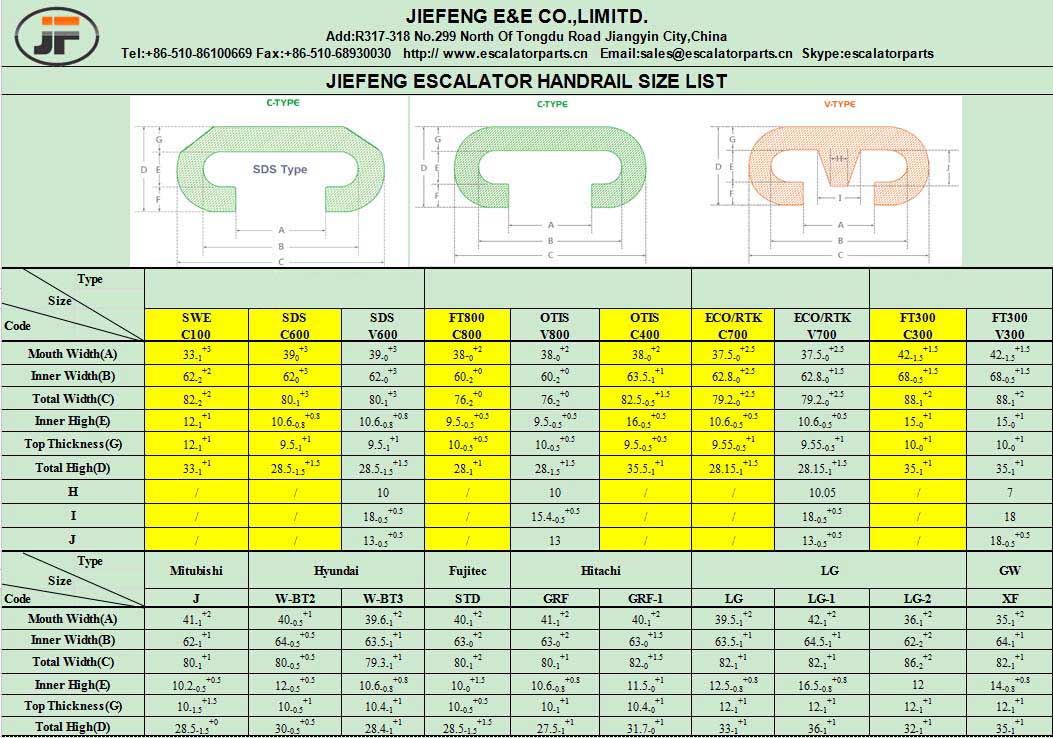- Sitemap
- |
- Download
- |
- Blog
- |
- Contact Us
- |
- Inquiry List
Categories
Contacts Info.
Detail Escalator Handrail
SWE C100 Rubber Escalator Handrail
Item No.: SWE/C100
Using for SH/FJ/BLT/CANNY/EXPRESS/GR/XIZI OT
- Maunal of escalator handrailDownload
- Cleaner and care jiefeng handrailsDownload
- Variants end preparation of handrailDownload
- Storage of jiefeng handrailsDownload
- Recycling incineration of jiefeng handrailsDownload
Description
SWE C100 Rubber Escalator Handrail
What is an Escalator Handrail?
An escalator handrail is the moving belt designed to provide passengers with a secure grip, helping them maintain balance and stability while using an escalator. Typically, escalators have two handrails—one on the left side and one on the right. These handrails are crucial for safety, especially for children, the elderly, and individuals carrying heavy loads.
Materials Used in Escalator Handrails:
Functions of Escalator Handrails
Escalator handrails offer several critical functions:
Structure of Escalator Handrails
Escalator handrails are made up of several layers, each contributing to their durability and smooth operation:
Comprehensive Overview of Escalator Handrails
Escalator handrails are essential for both convenience and safety in modern buildings. Below, we offer a detailed introduction covering their definition, functions, structure, and additional considerations such as colors, shapes, pricing, and safety standards.
1. Definition and Functions: An escalator handrail is a moving strap designed to be held by passengers, ensuring balance and stability while traveling on the escalator. Its primary functions include providing balance and support, assisting with safe transitions, and preventing accidents during sudden stops or unexpected movements.
2. Material and Construction: Escalator handrails are made from high-quality materials such as rubber, TPU, and CSM. They consist of several layers, including an outer cover (rubber or TPU), a core skeleton for support, a wire curtain to prevent stretching, and a sliding layer to reduce friction.
3. Colors and Aesthetics: Handrails come in various colors, allowing them to blend seamlessly into the building’s design or reflect a company’s brand. Common colors include black (stain-resistant and cost-effective) and gray (versatile and stylish). Many brands, such as IKEA (blue) and Uniqlo (red), use custom-colored handrails to reinforce their identity.
4. Shapes and Sizes: Escalator handrails typically come in Type C and Type V shapes, each suited to different types of escalator systems. The dimensions of the handrail (width, height, and edge measurements) must be accurate to ensure proper functionality and safety.
5. Pricing: Escalator handrails vary in price based on material and customization.
Please contact us for the best price.
6. Safety Standards: Handrails must adhere to strict safety regulations:
Conclusion:
Escalator handrails play an indispensable role in ensuring the safety and convenience of passengers. With options in material, color, and design, they can be tailored to meet both functional and aesthetic needs. When selecting escalator handrails, it's crucial to consider quality, safety standards, and the expertise of the supplier to guarantee reliable and efficient installation.
If you're interested in premium escalator handrails or have specific needs, please don't hesitate to contact a trusted supplier for assistance.
| Type | SWE/C100 |
| Details | Rubber black |
| Using for | SH/FJ/BLT/CANNY/EXPRESS/GR/XIZI OT |
 |
 |
You can check our pdf document of escalator handrail and contact us for more details.


What is an Escalator Handrail?
An escalator handrail is the moving belt designed to provide passengers with a secure grip, helping them maintain balance and stability while using an escalator. Typically, escalators have two handrails—one on the left side and one on the right. These handrails are crucial for safety, especially for children, the elderly, and individuals carrying heavy loads.
Materials Used in Escalator Handrails:
- Rubber Handrails: The most common type, used primarily in indoor settings like shopping malls, hospitals, etc.
- TPU (Thermoplastic Polyurethane) Handrails: Known for their superior appearance and durability, TPU handrails are often chosen for their glossy finish and are mostly used in retail spaces.
- CSM (Chlorosulfonated Polyethylene) Handrails: Ideal for outdoor installations due to their resistance to harsh weather conditions.
Functions of Escalator Handrails
Escalator handrails offer several critical functions:
- Balance and Stability: They provide essential support, especially for children, elderly passengers, and those carrying heavy items, ensuring a safe and comfortable ride.
- Facilitate Boarding and Alighting: Handrails assist in smooth transitions onto and off the escalator, reducing stress for users.
- Safety Feature: In the event of an unexpected stop or movement, the handrail offers a secure grip, helping to prevent falls.
Structure of Escalator Handrails
Escalator handrails are made up of several layers, each contributing to their durability and smooth operation:
- Outer Rubber Cover: The part passengers grip, made from durable and flexible materials like rubber or TPU. This outer layer provides comfort and traction.
- Skeleton Layer: This internal layer, often made from a nylon-polyester blend, maintains the handrail's shape and structural integrity.
- Wire Curtain: This stretch-inhibitor wire helps bear the load and keeps the handrail belt stable over time.
- Sliding Layer: Composed of cotton or synthetic fabrics, this layer minimizes friction, allowing the handrail to move smoothly without generating excessive heat.
Comprehensive Overview of Escalator Handrails
Escalator handrails are essential for both convenience and safety in modern buildings. Below, we offer a detailed introduction covering their definition, functions, structure, and additional considerations such as colors, shapes, pricing, and safety standards.
1. Definition and Functions: An escalator handrail is a moving strap designed to be held by passengers, ensuring balance and stability while traveling on the escalator. Its primary functions include providing balance and support, assisting with safe transitions, and preventing accidents during sudden stops or unexpected movements.
2. Material and Construction: Escalator handrails are made from high-quality materials such as rubber, TPU, and CSM. They consist of several layers, including an outer cover (rubber or TPU), a core skeleton for support, a wire curtain to prevent stretching, and a sliding layer to reduce friction.
3. Colors and Aesthetics: Handrails come in various colors, allowing them to blend seamlessly into the building’s design or reflect a company’s brand. Common colors include black (stain-resistant and cost-effective) and gray (versatile and stylish). Many brands, such as IKEA (blue) and Uniqlo (red), use custom-colored handrails to reinforce their identity.
4. Shapes and Sizes: Escalator handrails typically come in Type C and Type V shapes, each suited to different types of escalator systems. The dimensions of the handrail (width, height, and edge measurements) must be accurate to ensure proper functionality and safety.
5. Pricing: Escalator handrails vary in price based on material and customization.
Please contact us for the best price.
6. Safety Standards: Handrails must adhere to strict safety regulations:
- The speed of the handrail should align with the escalator’s steps (within a tolerance of 0%-2%).
- Anti-pinch devices must be installed at the handrail entry points to prevent fingers or objects from getting trapped.
- Minimum clearance of 80mm horizontally and 25mm vertically from surrounding structures.
- Handrail widths typically range from 70mm to 100mm for optimal safety.
Conclusion:
Escalator handrails play an indispensable role in ensuring the safety and convenience of passengers. With options in material, color, and design, they can be tailored to meet both functional and aesthetic needs. When selecting escalator handrails, it's crucial to consider quality, safety standards, and the expertise of the supplier to guarantee reliable and efficient installation.
If you're interested in premium escalator handrails or have specific needs, please don't hesitate to contact a trusted supplier for assistance.







